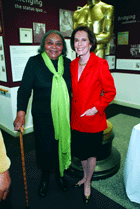Marian Anderson blazed a musical path; Juanita Moore, Susan Kohner made their marks in any otherwise middling film
There was glamour and to spare at the Metropolitan Opera Guild’s tribute to Marian Anderson (1897-1993) on October 19. Only the pioneering Anderson could have rallied forth such divas as stentorian Leontyne Price, imposing Grace Bumbry, still-gorgeous Shirley Verrett, Denyce Graves looking like the Beyonce of opera, and the adorable, humorous Martina Arroyo, who hosted the evening; only Jessye Norman and Kathy Battle were unaccounted for.
There was no live singing—for who, even among these stars, would dream of competing with Anderson? She was referred to as the black Statue of Liberty and, indeed, the imposing elegance and dignity with which she always presented herself, as well as that uncanny, deep voice and grave interpretive power were quite enough to transform the woman into virtual symbol.
Two seminal events of her life were covered, and each received its full due of drama and excitement. The first was Anderson’s Civil Rights trailblazer of a 1939 Easter Sunday recital at the Lincoln Memorial in Washington, D.C., when the Daughters of the American Revolution denied her the use of Constitution Hall. Actress Jane White, whose father, Walter White, was then the executive secretary of the NAACP described this event with awed reverence. Many remember White being mean to Carol Burnett as Queen Aggravain in the musical “Once Upon a Mattress,” but I’ve always worshipped her for her turn as the best movie madam ever, in “Klute,” especially when she described one very specialized “John” to Jane Fonda as “Mr. Clean.”
Anderson’s delayed operatic debut at the Met in “Un Ballo in Maschera,” at age 57 in 1954—the first performance by an African-American in a lead role on that stage—was glowingly recounted by Roberta Peters who played Oscar in that production. Peters still remembers that electrifying evening—the ovation that greeted the second act curtain rising on Anderson as the witch Ulrica, stirring her pot—as one of the highlights of her career.
Another African-American performer, Juanita Moore, got her due at the Academy of Motion Picture Arts and Sciences screening of “Imitation of Life” (1959) on October 17. Moore, of course, played Annie Johnson, faithful maid to Lana Turner, in the Douglas Sirk-directed weeper. Susan Kohner, who played her fair-skinned, mother-rejecting daughter, Sarah Jane, was also present.
“Imitation of Life” may not be a great film, but it is a great audience experience—from the campy main story of Lana Turner’s neglectful model-turned-movie star neglectful Mom, to Sandra Dee, to that jugular-lunging tale of Sarah Jane. It has a universal appeal, and even inspired Tweed Theater’s great parody “Imitation of Imitation of Life.”
Feisty and lovable, Moore who just turned 83, decried the crappy films that audiences have to watch today. She would be gratified to know that I saw the immortal “Imitation of Life,” the only film from Hollywood’s great days, on sale in a stand in Harlem next to the Apollo Theatre, alongside the Eddie Murphys and Martin Lawrences. She praised Sirk’s patience with her but Kohner differed, finding him too autocratic and “Prussian.” Both actresses were nominated for Supporting Oscars, but lost—perhaps because they split voters—to Shelley Winters for “Diary of Anne Frank,” and both actresses never received a comparable career opportunity after that.
Moderator Foster Hirsch got a little carried away, I think, with his overwrought analysis of, as he put it, “Sirk’s ironically commenting mise-en-scene,” citing the film’s opening at Coney Island as emblematic of the movie’s skin color theme—“Lana and her child are trying to get tans”—and some of Lana’s more outlandish drag, which elicited audience hooting, as being an intentionally ironic comment on her character’s foolish materialism. Nonsense! Costume designer Jean Louis was merely trying to make her look as young and chic as possible and, although her bubble coiffure and hostess ensembles seem risible today, his ass would have been fired had he attempted subversive injections into her wardrobe, something he never would have dreamed of doing, anyway.
There’s no denying, however, the effectiveness of the yellow dress Kohner wears in the scene when her racist boyfriend Troy Donahue beats the crap out of her and leaves her in the gutter. When I asked the huge-eyed Kohner—who looks exactly the same today—if Jean Louis had designed it, she said, “Oh, no! I think they bought everyone else’s clothes off the rack!” Someone else asked if she had done her own (obviously dubbed) singing, and she replied, “What do you think? I do wish I had rehearsed those dance moves more, though. But then Sarah Jane wasn’t supposed to have been very good, anyway!” Kohner reminded the audience of the subtler 1934 version of “Imitation,” which, although not as fondly remembered, was actually more progressive than her film, because the Annie character was not merely the leading lady’s maid, she was in full business partnership with Claudette Colbert, as inventor of a pancake mix.

Kohner doubtlessly drew on her own mixed heritage for her role, as the real-life daughter of Mexican actress Lupita Tovar and Hollywood super-agent Paul Kohner. She is the widow of men’s designer/author John Weitz and the mother of filmmakers Chris and Paul Weitz (“American Pie”). She was full of info about her sons’ latest projects but admitted that she is still waiting for them to offer a part.
I will be spending every spare moment I have down at the Film Forum, soaking up the movies of Mikio Naruse (1903-69), being screened through November 17. Naruse made 90 films, and has supplanted Akira Kurosawa and even Kenji Mizoguchi as my favorite Japanese director. One of the great directors of women in cinema, to rank alongside Mizoguchi, George Cukor, and Ingmar Bergman, Naruse usually centered his films around some extraordinarily beautiful female at a crucial moment in her life. They could be harrowing, like the soap-operatic “Floating Clouds,” which is like five Susan Hayward movies in one—rape, prostitution, adultery, self-sacrifice; or gentle, like the luminous Setsuko Hara in “Sudden Rain,” suppressing a yawn of boredom in one of the greatest examinations of stifling marriage ever made.
Many of Naruse’s works are suffused with a post-World War II ambiance of hardscrabble survival and eternal, financial concern, a far cry from the sleek, prosperous Japan evident in films today. It’s telling that this master is able to make, say, an aging bargirl’s quest for the cash to open her own place in his magnificent “When a Woman Ascends the Stairs” as purely compelling as any samurai revenge tale.
Contact David Noh at Inthenoh@aol.com.
Actresses Susan Kohner and Juanita Moore were both in attendance at a Academy of Motion Pictures Arts and Science screening of Douglas Sirk’s classis film “Imitation of Life.”
Marian Anderson’s imposing elegance, deep voice, and interpretive dexterity transformed her into a virtual symbol; her legacy was celebrated at a Met Opera Guild’s tribute on October 19.
gaycitynews.com




































